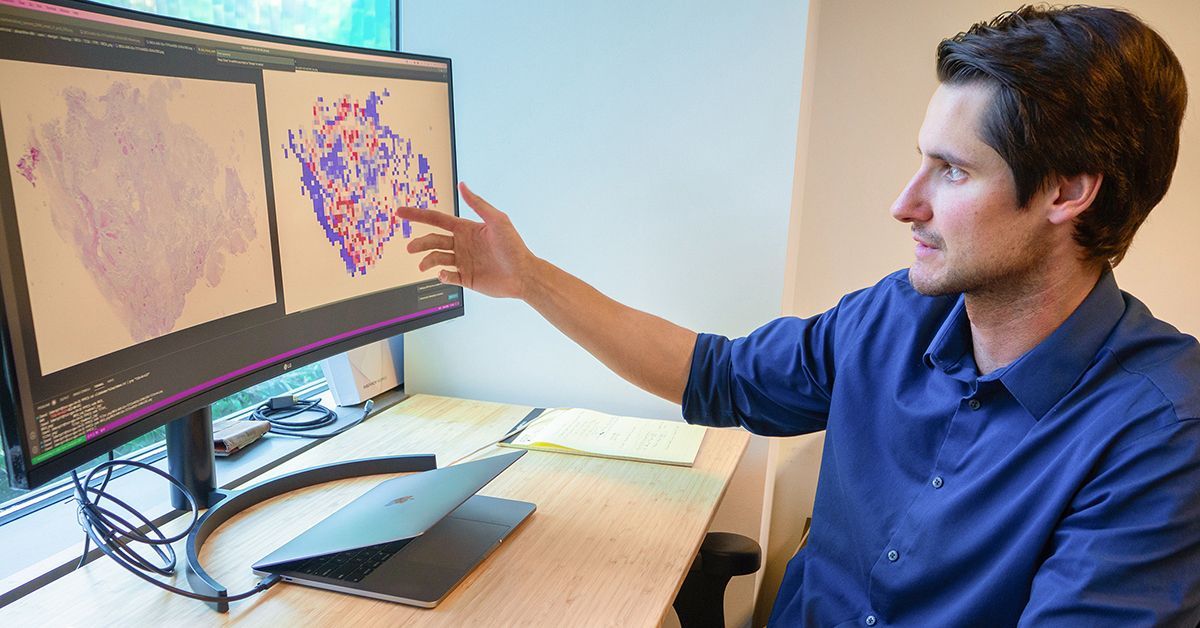AI Enables Rapid Identification of Targeted Cancer Therapy
UC San Diego researchers find that precision treatments for breast and ovarian cancers can start faster with AI-read biopsies.
Published Date
Story by:
Topics covered:
Share This:
Article Content
This story appears in the spring 2025 issue of UC San Diego Magazine as “Critical Diagnosis.”
When a patient is diagnosed with cancer, the time to treatment is critical.
“Today, a cancer patient can expect to wait weeks after their initial tumor diagnosis for a standard genomic test,” says Ludmil Alexandrov, professor at UC San Diego in both the Shu Chien-Gene Lay Department of Bioengineering and the Department of Cellular and Molecular Medicine. These tests are extremely important because they determine how active particular genes are in the tumor tissue, which can dictate the best treatments. Any delay in treatment can be life-threatening.
Artificial intelligence could change that.
For patients with breast or ovarian cancer, genomic testing can determine if a tumor shows a specific condition known as homologous recombination deficiency or HRD. This deficiency causes the cell to lose its ability to repair DNA breaks, thereby increasing the aggressiveness of tumors. Patients with HRD-positive tumors can significantly benefit from certain types of chemotherapy.
A recent study, led by Alexandrov and Dr. Scott Lippman, UC San Diego distinguished professor of medicine, Center for Engineering and Cancer, and Moores Cancer Center member, as well as Erik Bergstrom, PhD ’22, a postdoctoral researcher at UC San Diego, shows that a new AI tool can provide instant results at the biopsy stage about whether or not a tumor is HRD positive.
Using digital tissue slides from 1,008 breast and 459 ovarian cancer patients from The Cancer Genome Atlas project, the researchers trained a deep-learning AI platform to predict HRD positivity based on routine biopsy images. The model, called DeepHRD, uses a multiresolution decision in its analysis, similar to standard protocols used by pathologists. Interestingly, there are no visual tests that pathologists can use to diagnose the presence of the HRD biomarker. Yet, the AI model can discern subtle changes in the tissue structure that reveal the HRD status of each tumor.
“The AI tool essentially picks up these hidden features that are too complex for the human eye to pick up,” says Bergstrom. These are then compiled to diagnose whether the tumor is HRD positive.
“The AI test has a negligible failure rate, while current genomic tests have a failure rate of 20% to 30%, necessitating retesting or even invasive rebiopsy,” says Alexandrov. “This AI approach saves the patient critical time, and oncologists can prescribe treatment immediately after initial tissue diagnosis.”
This image-based analysis does even better than the FDA-approved genomic tests. “We were able to detect or resolve some ambiguous patients that the sequencing would fail to capture,” says Bergstrom.
Additional research will determine if the technique is as effective for other tissues and cancer types, including pancreatic and prostate cancers, where HRD is known to be clinically relevant.
This story was updated with additional information on June 13, 2025.
Learn more about research and education at UC San Diego in: Artificial Intelligence
You May Also Like
Stay in the Know
Keep up with all the latest from UC San Diego. Subscribe to the newsletter today.





